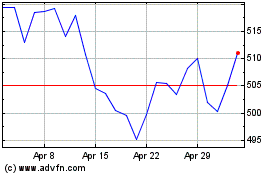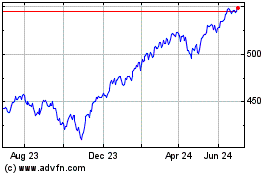What Next for Investors As S&P 500 Enters Bull Market Territory?
June 11 2023 - 4:27PM
Finscreener.org
The S&P
500 index entered bull
market territory last week, trading 20% above 52-week highs. U.S.
investors experienced its longest bear market since 1948, lasting
248 trading days. The shift back to a bull market took place
despite aggressive interest rate hikes by the Federal Reserve,
regional banking collapses, and persistent fears of a recession
that hasnU+02019t fully manifested.
Expect S&P 500 stocks to remain volatile in the
near-term
According to
Yahoo Finance, Ryan Detrick, Chief Market Strategist at
Carson Group, warns that the journey up for stocks might take a lot
of work. He studied 13 instances since 1956 where stocks rebounded
by 20% from a 52-week low. Typically, the first three months show
instability, with the benchmark index averaging a 0.5% decline in
the first month after hitting bull market territory.
However, the long-term view is
quite optimistic. DetrickU+02019s research shows that after a 20%
rebound from market lows, the S&P 500 typically returns 10%
over the next six months and 17.7% over the following
year.
Despite these optimistic
projections, the road to higher stocks may still be bumpy. On
Wednesday, markets expect the Federal Reserve to halt its interest
rate hike process, which
isnU+02019t necessarily good news for stocks. Economists predict
that the Federal ReserveU+02019s pause may be in anticipation of
the "lagging impact" of its fiscal policy.
Should this be the case, it could
result in slowed economic growth, which might lessen inflation but
pressurize earnings growth. Morgan Stanley recently referenced this
scenario when they forecasted a 16% drop in corporate profits by
year-end.
Inflation is on the radar of the Federal
Reserve
This Tuesday, weU+02019ll be
awaiting MayU+02019s latest Consumer Price Index (CPI), as released
by the Labor Department. The CPI is anticipated to have increased
by 0.2% in May, showing a slight deceleration from the 0.4%
increase in April. The forecast for the annual rate is 4.1%,
marking a decrease from the previous monthU+02019s
4.9%.
As for the core CPI, which leaves
out the more fluctuating food and energy prices, itU+02019s
predicted to have risen by 0.4% in the past month and by 5.3%
year-over-year, down from AprilU+02019s 5.5%.
The Producer Price Index (PPI)
for May, reflecting wholesale inflation, is set to be released on
Wednesday. After the 0.2% increase in April, producer prices are
predicted to have dipped by 0.1% in May, with the annual rate
likely slowing down to 1.5% from 2.3% in the previous
month.
The Federal ReserveU+02019s
Federal Open Market Committee (FOMC) will announce its decision on
interest rates. With the last ten meetings resulting in rate hikes
to temper inflation—which, while below its 2022 peaks, still
remains high—the central bank is widely anticipated to hold off on
further hikes in the upcoming meeting. The Fed funds rate is
expected to stay in its 5-5.25% range, and the CME GroupU+02019s
FedWatch Tool currently shows a 74.8% probability of a rate hike
pause.
The Census Bureau will deliver an
update on U.S. retail sales next week, providing insights into
consumer spending patterns and the impact inflation has had on
these. After two months of falling numbers, U.S. retail sales are
projected to have increased by 0.5% in May, following a 0.4% rise
in April, as shoppers wary of inflation start spending again. In
April, online shopping and food saw a surge in sales, whereas home
furnishings and electronics sales took a hit.
SPDR S&P 500 (AMEX:SPY)
Historical Stock Chart
From Oct 2024 to Nov 2024

SPDR S&P 500 (AMEX:SPY)
Historical Stock Chart
From Nov 2023 to Nov 2024
